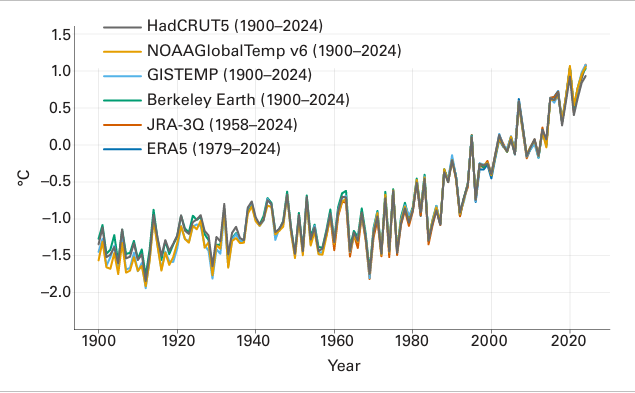The WMO (World Meteorological Organization) State of the Climate in Asia 2024 Report presents a clear and data-rich account of how Asia is being affected by accelerating climate change. Asia continues to warm nearly twice as fast as the global average. From glacier retreat to deadly floods, the report details the cascading consequences of climate extremes on human lives, economies, and ecosystems across the region.
1. Global and regional climate context:
Global background:
- In 2024, the global annual mean near-surface temperature was 1.55°C above the 1850-1900 pre-industrial average, making it the hottest year globally since records began in 1850.
- Atmospheric concentrations of greenhouse gases reached record highs in 2023.
- The ocean heat content also hit a record high, and global mean sea level rose at a rate of 4.7 mm/year (2015–2024).
Regional context (Asia):
- Asia's mean temperature in 2024 was 1.04°C above the 1991–2020 average, with widespread above-average temperatures.
- The warming trend for 1991–2024 was almost double that of 1961–1990.
- Japan recorded its warmest year ever, and large swathes of East and South Asia experienced record-breaking temperatures.
2. Key climate indicators:
Temperature:
- All six major datasets confirm that 2024 ranked as the warmest or second warmest year on record in Asia.
- The most anomalous warming occurred across western China to Japan, the Indochina Peninsula, the Middle East, and northern Siberia.

Precipitation:
- Above-normal rainfall affected areas such as: United Arab Emirates, Oman, Saudi Arabia, Southern Japan, Malaysia, China, Mongolia
- Below-normal precipitation was observed across regions in: Central Asia, Eastern Iran, Western Himalayas, Mongolia, parts of Afghanistan and Iraq
Cryosphere:
- Accelerated glacier mass loss was recorded, especially in the central Himalayas and Tian Shan, driven by reduced winter snowfall and extreme summer heat.
Oceans:
- Sea-surface temperatures across Asia’s surrounding waters were the highest on record.
- The decadal sea-surface warming rate in Asia was nearly double the global average.
- Marine heatwaves (MHWs) reached unprecedented levels, contributing to disrupted marine ecosystems.
- Sea level rise on both the Pacific and Indian Ocean coasts of Asia exceeded the global average, increasing risks for low-lying nations and coastal populations.
3. Extreme weather events:
Tropical cyclones:
- Cyclone Yagi was the most intense storm of the year, severely affecting Viet Nam, the Philippines, Lao PDR, Thailand, Myanmar, and China.
Flooding:
- Central Asia faced the worst flooding in over 70 years.
- In April, the UAE experienced 259.5 mm of rain in 24 hours, breaking records since 1949.
- Nepal’s September floods, triggered by record rainfall (239.7 mm in Kathmandu), resulted in at least 246 deaths and damages exceeding 12.85 billion Nepalese rupees. However, effective anticipatory actions benefited over 130,000 people.
Drought:
- By September 2024, China’s drought had affected 4.76 million people and damaged 335,200 hectares of crops, causing losses of 2.89 billion yuan.
- Severe droughts were also reported in Iran, Turkmenistan, western Kazakhstan, and Mongolia.
Heatwaves:
- Prolonged heatwaves spanned East Asia from April to November.
- Japan’s national summer temperature tied with the 2023 record, at 1.76°C above normal.
- India recorded over 450 deaths due to extreme heat.
Other extreme events:
- Cold wave in Russia (Tatarstan) in January brought anomalies of −9°C to −16°C below normal.
- Mongolia suffered a dzud (extreme winter), leading to livestock loss.
- Dust storms and sand events increased, especially in Iran, Afghanistan, and Turkmenistan.
- On 16 August, a glacial lake outburst flood (GLOF) in eastern Nepal triggered massive damage and displacement.
- Lightning strikes killed about 1,300 people in India, with 72 dying in a single event on 10 July.
4. Major climate drivers:
El Niño–Southern Oscillation (ENSO)
- An El Niño event began in mid-2023 and ended in early 2024.
- It significantly influenced:
- Heavy precipitation and heatwaves in East Asia
- Extreme rainfall in western and southwest Asia
Indian Ocean Dipole (IOD):
- The IOD remained mostly neutral, with brief signs of a negative phase towards the year’s end.
Asian monsoon:
- Rainfall over the Asian summer monsoon region was generally above normal.
- North China (83%), Korea (33%), and Yangtze River basin (51%) saw major rainfall increases.
- India’s monsoon rainfall was 108% of the climatological average (1971–2020), which is considered normal.
5. Impact and adaptation case study: Nepal
The 2024 floods in Nepal illustrated both climate risk and resilience. Despite severe rainfall and flooding, anticipatory action, early warning systems, and coordinated response helped protect over 130,000 people. The case reflects the potential of preparedness and early action in saving lives and reducing disaster impact.
This text is based on extracts from a report published by the World Meteorological Organization (WMO), 2025. To read the complete report, follow the link here.
See below for our coverage on similar topics:
- The Geopolitics of Climate Change in the Indian Ocean Region
- India’s Institutional Cooperation on Climate Resilience in the Bay of Bengal Region
- Climate risk report for the Southeast Asia region



